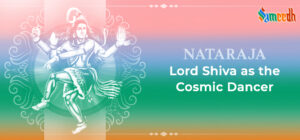The Nataraj form of Lord Shiv is a highly revered and iconic representation of Shiv in Hinduism. Nataraj, meaning “King of Dancers,” is a depiction of Shiv as the cosmic dancer who performs the Ananda Tandav, the dance of bliss, in the cosmic arena.

Nataraj, also known as Shiv Nataraja, is a Hindu deity who is associated with the dance of cosmic creation and destruction. Nataraj is a form of Shiva, the Hindu god of destruction, and is often depicted as a dancer who is performing the cosmic dance of creation and destruction.
According to Hindu mythology, Nataraj represents the cycle of birth, death, and rebirth that is inherent in the natural world. His dance is seen as a metaphor for the constant cycle of creation and destruction that occurs in the universe.
In Hindu art and literature, Nataraj is often depicted as a dancer who is performing the tandav, a powerful and energetic dance that is associated with the cosmic dance of creation and destruction. He is usually shown standing on one leg and holding a drum and a flame in his hands.
Nataraj is an important figure in Hinduism and is revered as a symbol of the cosmic dance of creation and destruction. He is also seen as a metaphor for the constant cycle of birth, death, and rebirth that is inherent in the natural world, and is often invoked in Hindu rituals and ceremonies.
Famous temples of Natraj
There are many famous temples of Nataraj, also known as Shiv Nataraja, in India and around the world. According to Hindu mythology, these temples are believed to be few of the 108 sacred sites of Shiv, and are an important place of pilgrimage for Shiv devotees. The temples are known for their beautiful and ornate architecture, and are important cultural and religious sites. They are home to a famous idol of Nataraj, which is made of stone and is decorated with gold and precious jewels. The idol is considered to be very powerful and is believed to be able to grant wishes to those who pray to it.
Some of the most famous temples of Nataraj include:
Chidambaram Temple, Tamil Nadu
Srikalahasti Temple, Andhra Pradesh
Ettumanoor Temple, Kerala
Kailasanathar Temple, Tamil Nadu
Prayers for Natraj
There are many prayers and mantras that are used to invoke the blessings of Nataraj, also known as Shiva Nataraja, in Hinduism. Some of the most popular prayers and mantras for Nataraj include:
“Om Namah Shivaya”: This mantra is one of the most popular and widely used mantras in Hinduism, and is often used to invoke the blessings of Shiv and his various forms, including Nataraj. The mantra is believed to have the power to purify the mind and bring peace and tranquility to those who recite it.
“Om Natarajaya Namah”: This mantra is specifically used to invoke the blessings of Nataraj and is believed to have the power to bring prosperity and success to those who recite it.
“Om Tandavaya Namah”: This mantra is used to invoke the energy and power of the tandava, the cosmic dance of creation and destruction that is associated with Nataraj. The mantra is believed to have the power to bring about transformation and change in the lives of those who recite it.
“Om Anandaya Namah”: This mantra is used to invoke the blessings of Ananda, the cosmic principle of joy and bliss that is associated with Nataraj. The mantra is believed to bring happiness and contentment to those who recite it.
Here are key elements and symbolism associated with the Nataraj form of Lord Shiv:
- Dance of Bliss: The Nataraj dance represents the cosmic cycles of creation, preservation, and destruction. It is a dance of bliss that symbolizes the eternal rhythm of the universe.
- Four Arms: Nataraj is typically depicted with four arms, each holding symbolic items. The upper right hand holds the damaru (a small drum), representing the sound of creation. The upper left hand holds Agni (fire), symbolizing destruction. The lower right hand is in the abhaya mudra (gesture of fearlessness), representing protection. The lower left hand points downward towards the raised left foot, signifying liberation.
- Cosmic Ring of Fire: The Nataraj is often shown standing on a pedestal within a ring of flames, known as the prabha mandala. The ring of fire represents the cosmic energy and the cycle of time.
- Lifting of the Left Leg: In the dance, Shiv lifts his left leg, symbolizing the release of the soul from the illusion of the material world and the process of liberation (moksha).
- Ganges River on the Hair: Shiv’s matted hair in the Nataraj form often contains the river Ganges flowing through it. This represents the descent of the divine Ganges from the heavens to the earth, and it also symbolizes purity.
- Apasmara Purusha: The dwarf demon under Shiv’s foot, known as Apasmara Purusha, represents ignorance and illusion. Shiv’s act of standing on the demon signifies the triumph of divine knowledge over ignorance.
The Nataraja form is not just a visual representation but also a symbolic expression of profound philosophical concepts within Hinduism, emphasizing the cosmic dance of creation and destruction and the eternal cycles of life and death. It is a popular and widely recognized symbol of Shiv’s cosmic role as the supreme deity in Hinduism.